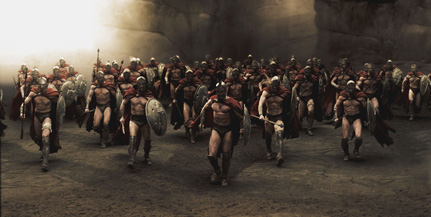What Went Right: 300
By Shalimar Sahota
March 5, 2012
Anyone who has been playing games since the 8-bit days will have experienced the side scrolling beat-em-up or platform adventure. Obviously there have been advancements since Double Dragon, yet even in some of today’s games the core remains the same; as the story progresses, the levels, battles and enemies become much harder. In an effort to accomplish their goal, the good guys end up injured and in some cases lives have been lost. Interestingly, this has become something of staple in all of Snyder’s films (less so in Watchmen, but it is there). At the time, any male who has vigorously waggled a joystick would be drawn to 300, even on a subconscious level.
What did Miller make of the film? After co-directing Sin City, he described in an interview with Esquire magazine how not being able to direct 300 was “painful,” saying, “I wanted to take Zack out back, beat him senseless, and take his job. Then I saw him do what he was doing and realized that I wasn't ready yet.” Miller was on board with the film, credited as an executive producer. “There are some differences,” he said, “but they are negligible. It really is my comic book come to life.”
Snyder cited how the Internet “really helped” when it came to spreading awareness and hyping the film. After a specifically created trailer was shown at the San Diego Comic Con in July 2006, the buzz began to spread to online movie sites. A couple of months later, a poor quality version of this trailer also managed to make its way online only to be quickly removed by Warner.
Nevertheless, the reaction was positive. The official trailers were brilliant, incorporating Nine Inch Nails’ Just Like You Imagined and featured Butler as King Leonidas screaming words of encouragement to his men. When watching them, there was a feeling that he wasn’t just speaking to his men, but to potential audiences. Hearing phrases like, “This is where we fight, this is where they die, take from them everything,” it’s as if he’s getting the audience ready for battle, pumping them up into believing that this film is the main event they’ve been waiting to see. It also upped the stakes by adding the tagline, “They were 300 men… against a million.” TV spots began airing in the US around two months before its eventual release, with some extended to a minute long.
Filming on blue screen helped bring the cost down, with the production budget at $65 million. 300 opened in the US on March 9, 2007. Warner Bros was expecting the film to open somewhere between $35 million - $40 million. It earned a staggering $70.8 million on its opening weekend, making more money than the rest of the films in the top ten combined. At the time it was the third largest opening for an R-rated movie, behind The Matrix Reloaded and The Passion of the Christ. Upon hearing how much the film had earned in three days, Snyder said, “It seemed like a mistake, an accounting error.” Though reviews from critics were mixed, it didn’t stop teenage boys (and men who still think they’re teenage boys) from heading to the multiplex.
When asked on why people flocked to the film, Snyder said, “At home, they’ve got a 50-inch plasma, surround sound, so really why go out? To me, I wanted to say: 'This is different. Look at this.' Whether or not it’s completely original is debatable, but there are pictures in the movie that you haven’t seen.” 300 stayed in the US top ten for six weeks and finished its run with $210.6 million. It also proved to be a monster success overseas, earning $245.4 million. A worldwide total of $456 million meant that Warners wanted a follow-up.
A year after its release, producer Nunnari revealed that a possible sequel or prequel to 300 was in the works. It turns out that Miller is working on a follow-up to his graphic novel, titled 300: Battle of Artemisia, with Warners already in the process of pre-production. Noam Murro is currently attached to direct.
The immortal line, “This is Sparta!” has been spoofed on numerous occasions, even by Butler himself; while the film has resulted in its own parody, Meet the Spartans. There have also been few somewhat similarly inspired imitators, as Warners went to work on that Clash of the Titans remake and Nunnari helped finance Immortals.
After watching that teaser trailer, I initially wasn’t that keen on 300. It looked like a violent macho spectacle with no redeeming features. But as the marketing continued, the overwhelming odds and the determination of the 300 began to seep through. I viewed the film on its opening day and found it to be absolutely nuts. Seeing it again five years later, I still think it is, but given the insane story that’s being narrated to us, I also see it as more of as a man’s man’s fairy tale.
So where’s the deep intellectual message? 300 is clearly not a masterpiece by any means, but it does what it sets out to do, succeeding as grandiose nonsense delivering an act of courage defined by violent battles. Sometimes that’s enough to interest audiences and keep them satisfied, but it helps when some effort has gone into making it look as visually spectacular as it possibly can be.
Continued:
1
2
3
|
|
|
|




